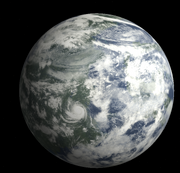
Ganymede is one of the moons of Jupiter. It is believed that it should be one of the bodies taken into consideration when it comes to space colonization. It is far larger than our own moon . It is in fact the largest moon in the Solar System and it has a greater diameter than planet Mercury. However Mercury has more mass than Ganymede.
It is possible that Ganymede has liquid water under the surface. If this is correct, it could be terraformed and heated by adding greenhouse gases such as Sulfur Hexafluoride and Nitrogen Trifluoride. Sulfur is found in large quantities on Io, another one of Jupiter's moon. Another advantage is that Ganymede has a strong magnetosphere in addition to Jupiter's, which is believed to be important in holding an atmosphere.
The day on Ganymede is about 3.5 Earth days, so the rotation must be sped up.
Its size is much smaller than Earth's, so Ganymede may not have enough gravity to permanently hold an atmosphere. However, it would take thousands to tens of thousands of years for it to finally lose its atmosphere. Furthermore, the magnetosphere, along with Ganymede's distance from the sun would slow the process. The ice on the surface can be converted into oxygen for the atmosphere, which could be made into Carbon Dioxide. More CO2 could be taken from Venus, which has enough atmosphere, including nitrogen which can also come from Titan, to terraform several worlds.
Life and Economy
Should an outer layer of greenhouse gases be thick enough, Ganymede will have enough heat to keep the oceans liquid. Cities can be built in traditional Earth-style cities, or on the water. Life on Ganymede will be much like life on Earth or Mars.
Life can be like most areas in the Solar System, First will come bacteria (preferrably cyanobacteria), mosses, hardier plants, and algae to create oxygen. Once enough oxygen is developed, complex life may be added. potentially with some genetic engineering to keep them alive.